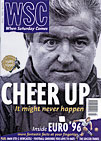 Mike Ticher has been leafing through revised edition of Simon Inglis's Football Grounds of Great Britain
Mike Ticher has been leafing through revised edition of Simon Inglis's Football Grounds of Great Britain
Between 1975 and 1985, there was perhaps only a single football book published in Britain that could genuinely be called a classic. Simon Inglis’s The Football Grounds of England and Wales (1983) was a revelation for two reasons. First, because it appeared at a time when football was grossly unfashionable. Second, because it differed utterly in form and content from the landmarks in football publishing which both preceded and followed it.
From The Football Man, The Glory Game and Only a Game? through to Fever Pitch, All Played Out and Football Against the Enemy, football writing was about close observation and reinterpretation of the known football world. Although in some cases the authors had privileged access to the inside of that world, their work was essentially opinionated and anecdotal. Inglis was different. He had another weapon, so often scarce in football writing. Original facts. Gritty, stubborn little mongrels, every one of them demanding painstaking labour to unearth, as well as flowing prose.
Inglis not only made fans look around themselves with completely new eyes, he also proved that solidly-researched football history could be written for and devoured by a non-academic audience – though few enough have followed his example since.
It was the book that lent the first hints of respectability to the obsessional quality of being a fan (which he so obviously was). No doubt to the amazement of the publishers, the world of cantilevers, translucent panelling and roof fascias found an eager audience. But now that the seam of obsession has been mined to exhaustion, it’s the quality and depth of his research (as well as the fortuitous topicality of his subject matter) which continues to set Inglis’ work apart in this superb new edition.
With the wholesale changes to British grounds in the wake of the Taylor Report, it was inevitable that it would be a monster. All the new developments are of course exhaustively documented and critically appraised. It would still have been a great book if these had been roughly cobbled on to the text of the first two editions. But in fact Inglis has also completely rewritten and, in many cases, vastly expanded the original historical material as well. An awesome undertaking.
In other ways, too, the new edition is far more than merely an update. Like so many others, Inglis’ views have become steadily less prone to nostalgia and sentiment over the years. His clear-eyed reasoning on the demise of The Kop is typical of that process, and of the authority which stems from the mastery of those endless, and often discomforting facts. The fact, for example, that before 1994 there would be 10-25 people treated for injuries sustained on The Kop at every game.
Perhaps the greatest asset of the three editions has been their timing. The first documented a world about to disappear, a world in which stands had remained untouched for decades, with both picturesque and appalling results. The second (1987) was a snapshot of that uneasy time between Heysel and Hillsborough when football knew it had to reform, but was scratching around for a sense of direction, not to mention the huge wads of cash required to effect fundamental change. The third has been delayed long enough to chronicle the building frenzy which followed the Taylor Report and the influx of said wads.
Together they are not just a history of grounds, but also of a changing culture, the destruction of ways of thinking and behaving which seemed like the natural order of things only a few years ago. “It is unlikely that such a large, expensive stand as this (Chelsea’s East Stand) will be built again in Britain,” he wrote in 1983. Now they’re ten a penny, and Old Trafford is to have one more than twice the size.
One quibble. The previous two editions of the book have sold 120,000 copies, after an initial print run of 4,000 in 1983. Given this amazing windfall, it seems churlish in the extreme that the publishers have so conspicuously failed to match Inglis’s meticulous attention to detail in the latest edition. Careless typographical errors abound (“The sight of Huddersfield’s new stadium lies just across the River Colne”) and the use made of dozens of excellent new photos is feeble. Maddeningly, far too many are too small to illustrate the point Inglis is making, while others are very poorly reproduced.
None of which succeeds in seriously diminishing the book as a whole. It’s a classic in its own right.
From WSC 113 July 1996. What was happening this month